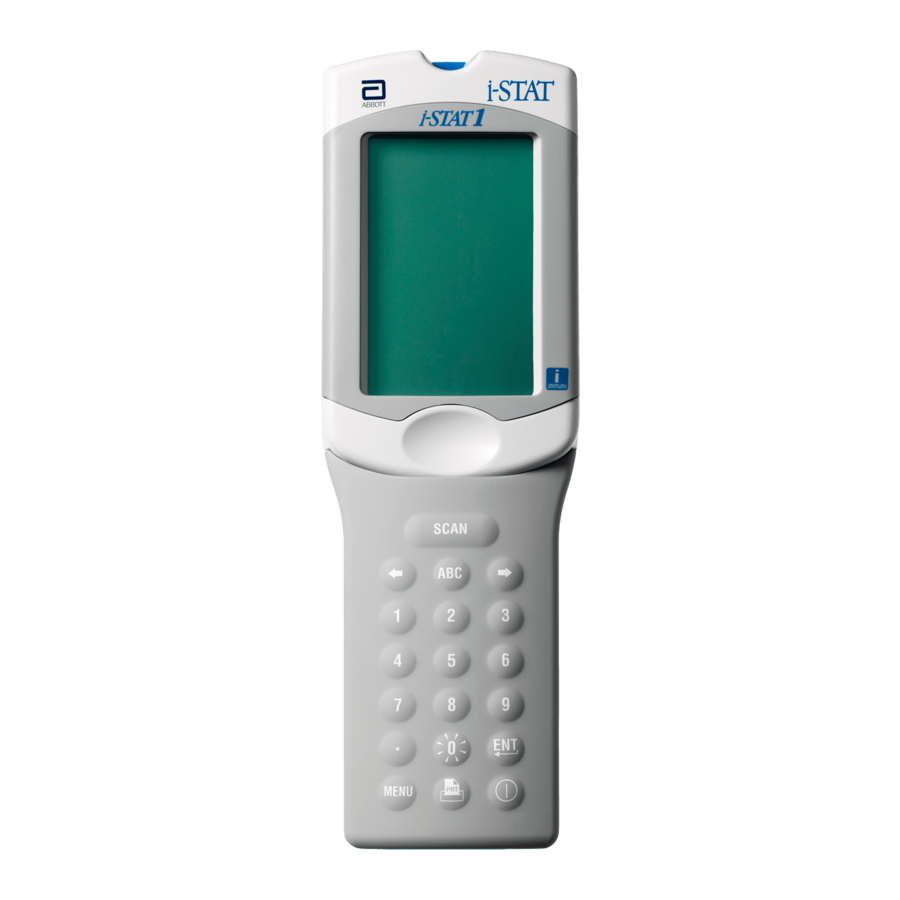- ページ 3
計測機器 Abbott i-STATのPDF ユーザーマニュアルをオンラインで閲覧またはダウンロードできます。Abbott i-STAT 11 ページ。 Wireless analyzer
Abbott i-STAT にも: テクニカル・ニュース (12 ページ)

Quality Check Messages and Codes
Message
Cause
Sample Positioned
Cartridge underfilled.
Short of Fill Mark
Sample Positioned
Cartridge overfilled.
Beyond Fill Mark
Test Cancelled by
User did not respond
Operator
to mandatory prompt
before analyzer time
out.
Cartridge Type Not
Software does not
Recognized
recognize cartridge.
Analyzer Error, Use
Handheld detects
Electronic
problem from which it
Simulator
is likely to recover.
Analyzer Error,
Handheld detects
See Manual
problem from which it
may not recover.
No display
Disposable batteries
dead or rechargeable
battery fully
discharged. Keypad
not responding. Start
switch broken.
Cartridge Locked
Dead battery(s).
does not disappear
Mechanical
after test cycle
problem.
completed
18
(continued)
Action
Use another cartridge - fill to Fill
Mark.
Use another cartridge - do not fill
beyond Fill Mark.
No action required.
Update software. Check to see if
cartridges are expired.
Insert the Electronic Simulator. If
PASS, continue to use handheld.
Insert Electronic Simulator. If PASS,
insert a cartridge with sample
or control. If the code does not
reappear, continue to use handheld.
Change disposable batteries or
recharge battery. If still no display,
call Support Services.
Wait until handheld turns off. Turn
handheld on. If resets, remove
cartridge. If not, change or recharge
battery(s) and turn handheld on.
Blood Collection
Acceptable Samples for Cartridges
n
Arterial: Plain syringe, heparinized syringe labeled for analytes to be tested and filled to
capacity, or syringe with minimum volume of heparin to prevent clotting (10 U/mL of blood).
For ionized calcium, use balanced heparin syringes. Mix heparinized syringes by rolling
between palms for at least 5 seconds in two directions, then invert the syringe repeatedly
for at least 5 seconds. Test for lactate immediately. Samples for pH, PCO
ionized calcium should be tested within 10 minutes. Test other analytes within 30 minutes.
•
Avoid drawing air into syringes for blood gas and ionized calcium tests.
•
If not tested immediately, remix and discard 2 drops of blood before filling cartridge.
•
Do not use iced samples.
n
Venous: Collection tube with lithium heparin filled to capacity and mixed by gentle
inversion at least 10 times. Test within 10 minutes.
•
Do not leave tourniquet on for more than 2 minutes.
•
Do not draw above an I.V.
n
Skin puncture: Lithium heparin capillary tubes for testing all analytes except ionized
calcium. For all analytes, including ionized calcium, use plain or balanced heparin
capillary tubes. Test immediately.
•
Allow alcohol to dry over puncture site before collecting sample.
•
Do not "milk" finger or heel while collecting sample.
n
Coagulation Tests:
•
The ACT test may be performed using venous or arterial samples, while the PT/INR
test may be performed using capillary or venous samples.
•
Use plain plastic syringes or plastic evacuated tubes with no anticoagulant,
activators, or serum separators.
•
Test sample immediately upon draw.
•
For venipuncture, some experts recommend drawing and discarding a sample of
at least 1 mL prior to drawing samples for coagulation testing.
•
If a second measurement is needed, draw a fresh sample.
•
For indwelling line testing for ACT:
a.
Fluid drip through the line must be discontinued.
b.
If blood must be drawn from an indwelling line, possible heparin contamination
and specimen dilution should be considered. The line should be flushed with
5 mL of saline and the first 5 mL of blood or six dead space volumes should be
discarded.
c.
Withdraw the sample into a fresh plastic syringe with no anticoagulant and
test immediately.
•
For extracorporeal line testing for ACT:
a.
Flush the extracorporeal blood access line by withdrawing 5 mL of blood
into a syringe and discard the syringe.
b.
Withdraw the sample into a fresh plastic syringe with no anticoagulant and
test immediately.
, PO
TCO
and
2
2 ,
2
3
